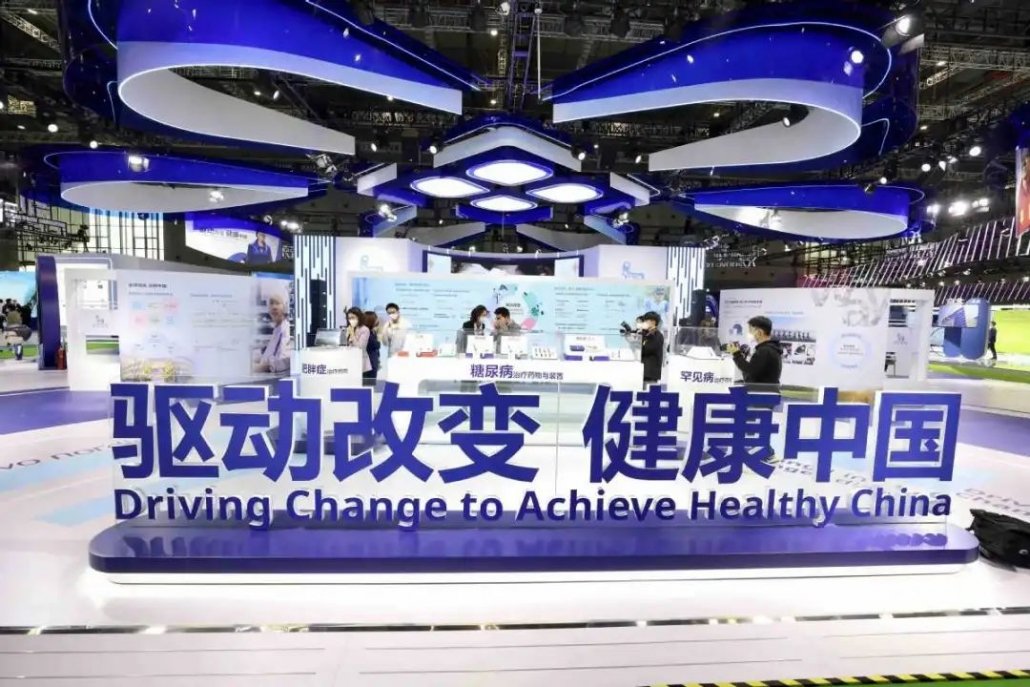
Visitors gather at Danish pharmaceutical company Novo Nordisk’s booth during the fifth China International Import Expo in Shanghai in November. [PHOTO by ZHU XINGXIN/CHINA DAILY]
MNCs share confidence to invest, expand with nation’s high-standard opening-up
As the first multinational healthcare company to settle in the Lingang Special Area of the China (Shanghai) Pilot Free Trade Zone, Danish pharmaceutical company Novo Nordisk announced at the end of last year that it would invest 400 million yuan ($59.6 million) in a newly established company in the area.
With that investment, the company will upgrade its whole industrial layout in China to better seize the opportunities of China’s high-quality development, said Zhou Xiaping, global senior vice-president of Novo Nordisk and president of Novo Nordisk China.
That’s just one example from the past year of foreign pharmaceutical enterprises casting a vote of confidence in China’s market to expand their investments, eyeing brightening prospects.
China, the world’s second-largest economy and pharmaceutical market, only after the United States, has been playing an increasingly growing role in the global pharmaceutical market, both as a consumer country and as a crucial link in the global pharmaceutical industrial and supply chains.
The annual tone-setting Central Economic Work Conference, held in December, said China will make greater efforts to attract and utilize foreign capital, widen market access, promote the opening-up of modern service industries and grant foreign-funded enterprises national treatment.
The innovation and creativity potential of the whole society should be unleashed to the greatest extent, while the potential of the domestic market will also be fully tapped so that domestic demand can play a stronger role in driving economic growth, according to the meeting.
Experts and business leaders said China’s unwavering commitment to deepening reform and expanding high-level opening-up, its stress on innovation and technological advancement, and the fast-growing pharmaceutical market in China due to the large population’s increasing awareness and spending on healthcare products and services, will jointly shore up foreign investment into its pharmaceutical industry despite challenges and complexities from the external environment.
They also said sectors such as biomedicine, vaccines, antivirus solutions, and in particular, rare diseases and chronic disease treatments, have especially huge growth potential.
Seeing the China market potential and impressed by China’s resolve to expand high-level opening-up, Japanese pharmaceutical company Astellas has set a strategic focus on breakthroughs in oncology and innovative drugs and therapies in China.
Currently, it is accelerating the introduction of innovative drugs to China and enhancing accessibility, which include a first-in-class antibody conjugate drug.
“China has always been a vital market for Astellas’ global growth and it has now risen to the top tier of Astellas’ global strategic markets based on its strong performance and significance,” said Hiroshi Hamaguchi, chairman and president of Astellas China.
“As the world’s second-largest pharmaceutical market, China presents us with great development potential with tremendous unmet medical needs … we will continue to leverage China’s favorable policies, and work with the government and all business partners to actively explore every possibility of (drug registration) acceleration,” he said.
Huang Feng, chairman of the Shanghai Foreign Investment Association, said foreign investors and multinational companies have advanced research and development technology and experience to meet China’s huge market demand, which will ensure promising growth prospects of foreign investment into China’s pharmaceutical industry.
In particular, the country’s newest catalog of industries for attracting foreign investment, which took effect on Jan 1, continues to encourage foreign investment in the manufacturing industry and has shed a spotlight on sectors including rare disease drugs, children’s medicines and high-end medical devices, he said.
 People check out the booth of US-based drugmaker Organon during the fifth CIIE. [Photo provided to China Daily]
People check out the booth of US-based drugmaker Organon during the fifth CIIE. [Photo provided to China Daily]According to a recent report by the R&D-based Pharmaceutical Association Committee, China’s continuous opening-up has attracted an increasing number of multinational pharmaceutical companies to fully participate in China’s market, initially being distributed in coastal cities such as Shanghai, Tianjin, as well as Hangzhou in Zhejiang province, Suzhou in Jiangsu province and Guangzhou in Guangdong province.
Their investments have expanded to cities in inner regions, such as Changsha in Hunan province, Wuhan in Hubei province, Chengdu in Sichuan province and Xi’an in Shaanxi province. They have also expanded investments from focusing on market and manufacturing to R&D in China, the report said.
Industry experts said China has become not only an important market, but also a source of innovation for multinational pharmaceutical companies.
With the inauguration of its regional headquarters in Qingdao, Shandong province, in late 2022, United Kingdom-based global pharmaceutical company AstraZeneca has officially completed a new layout in China — Shanghai for its main headquarters and Beijing, Hangzhou, Chengdu, Guangzhou, Wuxi in Jiangsu province and Qingdao as its six regional headquarters.
Last year, AstraZeneca unveiled a plant in Qingdao and announced additional investments of 100 million yuan and 180 million yuan, respectively, into its two existing production and supply bases in Wuxi and Taizhou in Jiangsu province.
Currently, the company has expanded its operations to new areas such as rare diseases, autoimmunity, vaccines and infections, while continuing to deepen its long-term strengths in areas including oncology, cardiovascular, metabolism, respiratory and gastrointestinal diseases.
All the projects in AstraZeneca China’s R&D pipeline in 2022 were developed simultaneously with its global R&D plan.
“As the Chinese government and the public attach greater importance to health with economic development, a lot of supportive policies and clearer guidance and regulations have been introduced,” said Wang Lei, executive vice-president of AstraZeneca and president of AstraZeneca China.
“AstraZeneca sees great opportunity in accelerating innovation through cooperation in China,” he said, adding that the company will continue to increase investment in the country.
China’s potential in the pharmaceutical market and innovation has also attracted the attention of top players in statistical software and advanced analytics for clinical trial design and execution.
US-based Cytel, which officially entered China in 2020, said it will strengthen efforts to deepen its development and continue to increase investment in the country.
“We believe that under the guidance of the Chinese government’s policy of expanding high-level opening-up and widening market access, foreign-funded enterprises will have greater development opportunities in the market,” said Jing Ping Yeo, vice-president and head of Asia-Pacific at Cytel.
Cytel’s statistical analytics software enables its clients to explore more strategic options to mitigate the risk of clinical trials and experiment with the benefits of complex trial designs.
It plans to build a strong local team in China in 2023 and scale up its offices and operations in Shanghai, Beijing and other cities. It is also actively working with various partners in China to jointly create a one-stop full-service provider for clinical research services.








